Elevate your culinary creations and gardening journey by transforming your outdoor area into a vibrant herb haven. Discover 27 unique herbs perfect for enhancing both your dishes and your garden. Whether you’re an experienced gardener or a beginner, cultivating your own herbs adds incredible flavor to your meals. Plus, it brings a refreshing touch of nature right to your backyard. Let’s explore the wonderful world of herb gardening!
Soil Preparation Techniques for Healthy Herbs
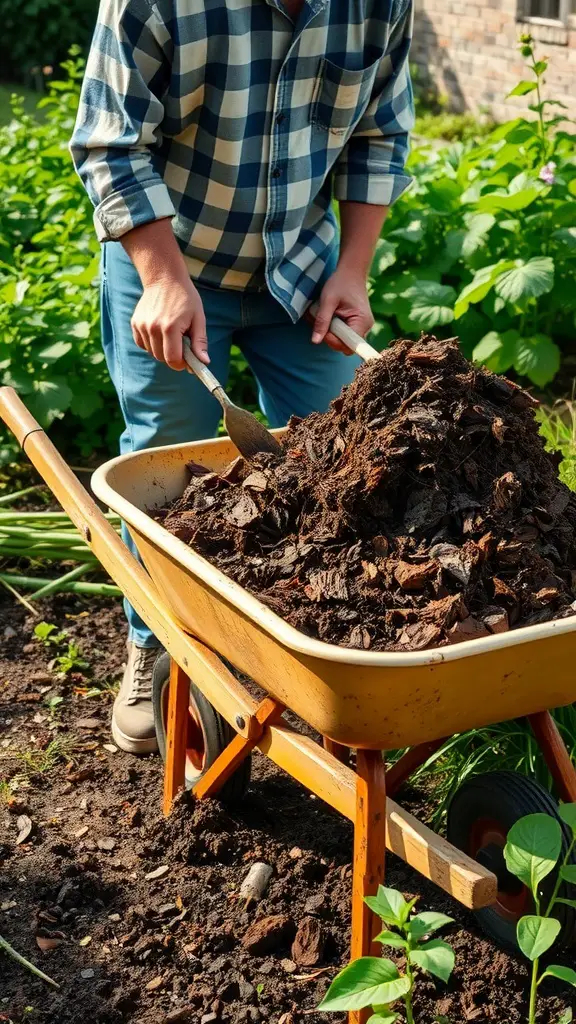
Preparing your soil is crucial for cultivating robust herbs. The image shows someone filling a wheelbarrow with dark, nutrient-rich compost. This is an essential part of soil preparation. Compost enriches the soil and enhances its structure, enabling herbs to flourish.
Begin by preparing your herb garden space. Eliminate all existing weeds and debris. This ensures optimal growth for your new herbs. Then, enrich the soil with organic materials such as compost. This improves drainage and moisture retention.
Before planting, analyze your soil’s texture and pH levels. Most herbs thrive in well-drained soil, ideally with a pH of 6 to 7. If your soil is dense, use a shovel or tiller to aerate it. This promotes healthier root development for your herbs.
Test your soil! Garden centers offer easy-to-use kits. Understanding nutrient levels guides your amendments. With prepared soil, plant your preferred herbs!
Watering Guidelines for Optimal Herb Growth
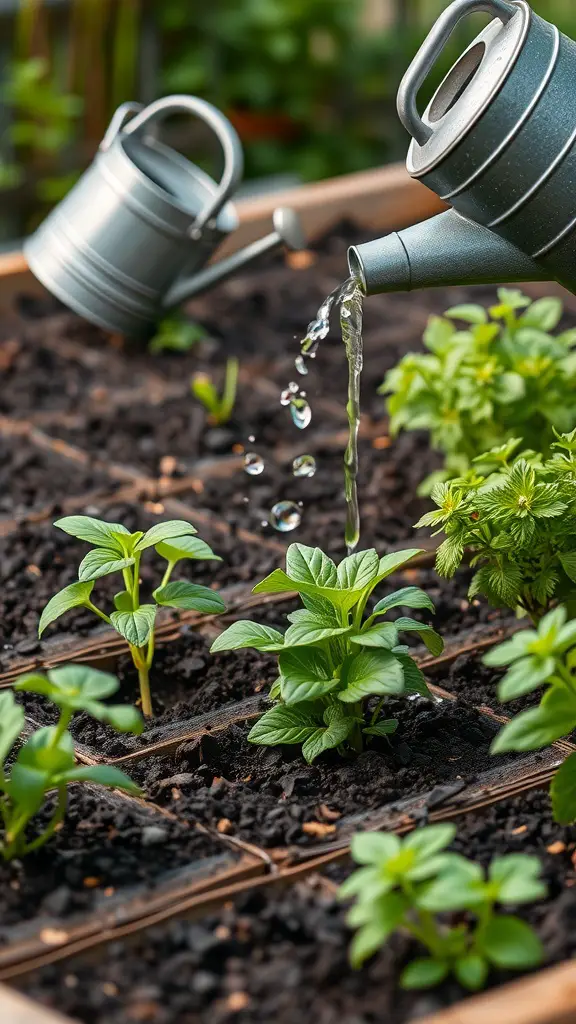
Effective watering is key to a flourishing outdoor herb garden. This image shows a watering can gently hydrating young, healthy herbs. Notice the freshly moistened soil, vital for robust plant development.
Remember that herbs thrive in well-drained soil. Avoid overwatering, which causes root rot. Water thoroughly, letting the top inch of soil dry before the next watering. This ensures healthy growth in 2025.
Weather significantly impacts your herbs. Expect to water more on hot, sunny days than on cooler ones. Regularly inspect your plants; drooping leaves signal thirst.
Opt for a watering can similar to the one pictured. Its gentle flow prevents soil washout. Water your herbs early in the day. This allows them to soak up moisture before the sun gets too strong.
Choosing the Right Location for Your Herb Garden
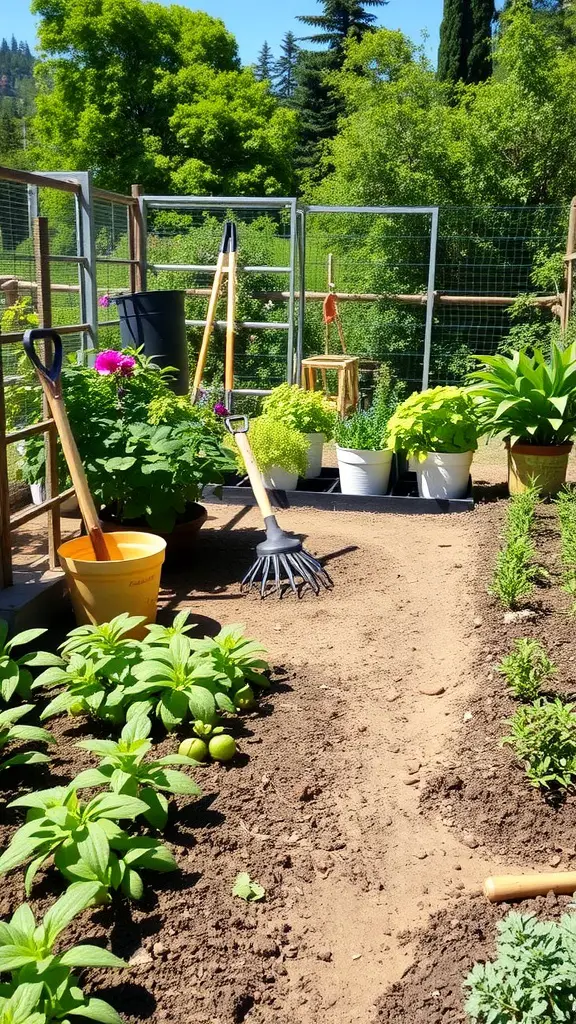
Choosing the perfect location for your herb garden involves careful planning. Think about the surrounding environment. The picture displays a flourishing outdoor garden with diverse plant life. Notice the gardening tools, such as a shovel and rake, placed near the herbs. These tools suggest a well-maintained and productive garden.
Sunlight is crucial when selecting the perfect herb garden location. Herbs flourish with ample light exposure. Aim for a spot that receives a minimum of six hours of direct sunlight each day. The lush greenery hints at a sunny environment, perfect for cultivating your herbs.
Accessibility is key. Ensure your garden is easily reachable. The visible path offers smooth movement, simplifying plant care. Effortlessly access your herbs for watering, harvesting, or culinary use.
Consider drainage as a key factor. Herbs thrive in well-drained soil. Soggy conditions can harm them. The garden pictured features clearly defined soil sections. This design helps avoid water accumulation around the plants. Selecting a spot with excellent drainage promotes healthy and vibrant herb growth.
Companion Planting Strategies for Herbs
Observe this thriving herb garden, where diverse plants flourish in unison. A tapestry of textures and verdant hues highlights nature’s splendor and the advantages of strategic companion planting, updated for 2025 gardening practices.
Companion planting involves strategically pairing plants for mutual benefit. For instance, rosemary and basil flourish when grown in close proximity. Rosemary naturally deters pests that could damage basil, promoting healthier growth.
This image showcases the vibrant, verdant foliage common in herb gardens. Observe the varying heights of the herbs. Rosemary, for example, stands tall, while mint and oregano remain more compact. This variety boosts visual interest and fosters a thriving garden ecosystem.
Cilantro and chives are another fantastic combination. They thrive together, sharing similar needs. Plus, they draw in helpful bugs that manage pests. Consider these connections when designing your garden for thriving herbs.
Varying plant heights and foliage types optimizes garden space. Taller plants offer shade, benefiting shorter ones and retaining soil moisture. Consider these interactions when arranging your herbs for best results!
Growing Herbs from Seeds vs. Transplants
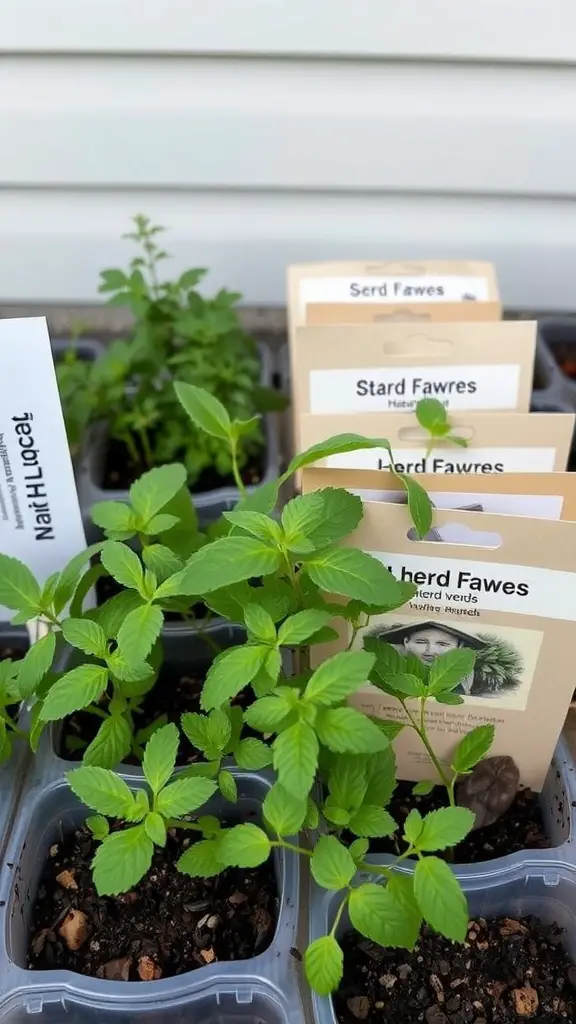
Observe this flourishing herb garden! Young plants are thriving in small, comfortable pots. Clear labels identify each herb variety. The vibrant green leaves indicate robust health. Imagine the delicious meals these herbs will enhance!
Choosing between herb seeds and transplants involves weighing several factors. Growing from seeds offers a fulfilling journey, letting you witness the complete plant life cycle. This method demands more patience, as germination and growth take time. However, it’s often cheaper and provides access to a broader selection of herb varieties.
Alternatively, transplants offer a significant advantage. These young, established plants readily acclimate to their new surroundings. This approach is perfect for gardeners eager to harvest fresh herbs faster. Furthermore, it bypasses the occasionally challenging seed germination process.
The final decision hinges on your gardening preferences and available time. Growing these plants, whether from seeds or seedlings, offers immense satisfaction, culminating in a flavorful harvest!
Herbs That Thrive in Containers

Growing herbs in containers is a fantastic option, particularly when space is at a premium. This captivating photo displays a lively assortment of potted herbs, crafting a welcoming and appealing ambiance ideal for every gardening enthusiast in 2025.
Basil, parsley, and cilantro thrive in pots. These herbs require excellent drainage and ample sunlight. Containers provide the perfect environment for them. The vibrant flowers enhance the visual appeal, beautifully contrasting with the herbs’ lush green foliage.
Select containers that promote airflow around the roots. Both plastic and clay pots are suitable. Crucially, ensure they include drainage holes. This prevents water accumulation, guarding against root rot.
Consistent watering is key for healthy herbs, particularly during hot weather. Monitor soil moisture each day. Water when the topsoil feels dry. Supplementing with a balanced fertilizer every few weeks will boost growth and enhance flavor.
Remember to harvest your herbs frequently. Regular harvesting encourages fresh growth. This guarantees a steady supply for your cooking needs. Add fresh basil to your pasta. Garnish your dishes with cilantro. Homegrown herbs are a wonderful addition to any meal!
Essential Tools for Herb Gardening Success
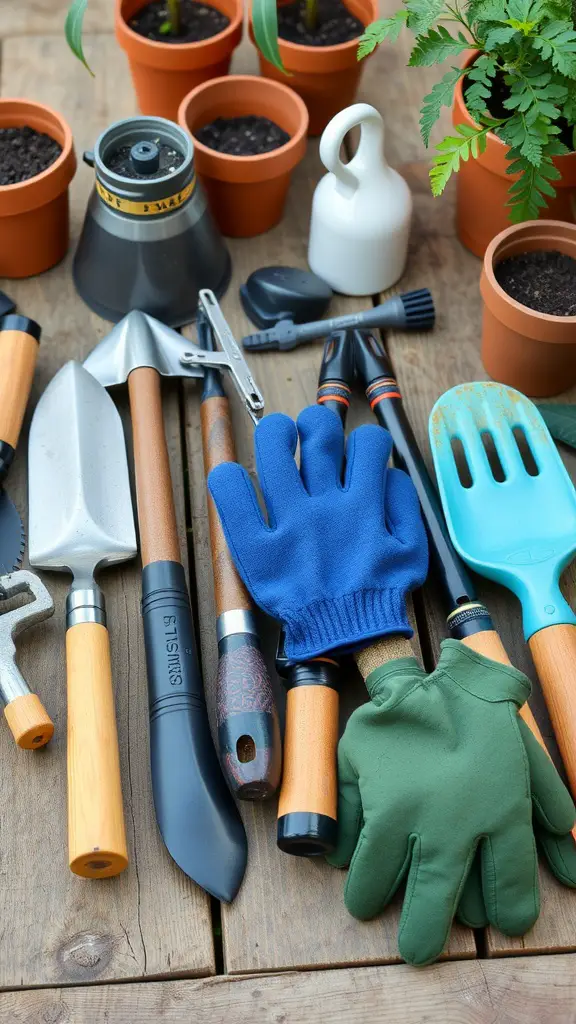
Growing herbs is a fantastic way to bring fresh, vibrant tastes to your kitchen straight from your garden. Using the correct tools is key for a successful start. The picture displays a selection of vital gardening implements arranged carefully on a wooden table, prepared for use.
Let’s start with gloves. Quality gloves safeguard your hands during gardening tasks. These durable blue gloves appear ideal for digging and planting in 2025. Combine them with key tools such as a trowel and hand cultivator. These are vital for planting seeds and aerating the soil effectively.
Observe the watering can, essential for maintaining herb hydration. Water gently to protect delicate seedlings. The soil-filled pots suggest new herbs ready for planting. Crucially, ensure proper drainage by using pots with bottom holes.
Additional useful tools are a weeder for efficient weed removal and a spade for more substantial digging tasks. Each tool simplifies herb garden maintenance, reducing overall effort.
Equipped with these key tools, you’ll be ready to cultivate a flourishing herb garden. Collect your supplies, prepare yourself, and let’s start planting!
Sunlight Requirements for Different Herbs
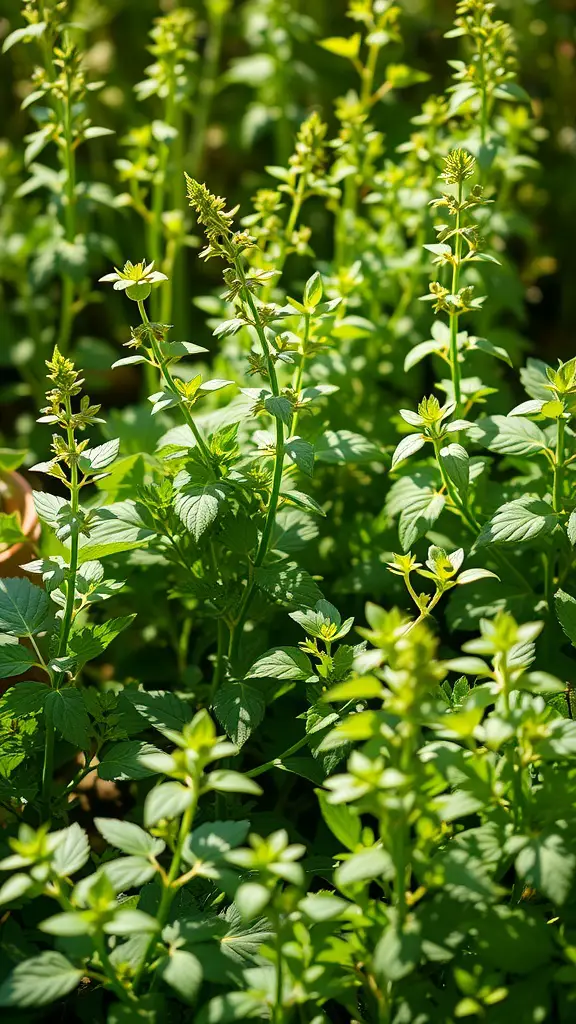
Cultivating your personal herb garden is a fantastic method to elevate your culinary creations and relish nature’s beauty. Different herbs require specific amounts of sunlight, which directly affects their development and taste. Knowing these sunlight needs is crucial for a flourishing herb garden in 2025.
These lush, green herbs thrive in a sunny environment, as the image suggests. Most herbs need at least six hours of direct sunlight each day. This is crucial for sun-loving herbs such as basil, rosemary, and thyme to flourish.
Parsley and mint are examples of herbs that thrive in partial shade. They’re excellent choices for gardens lacking full sunlight. Morning sun exposure is ideal for these herbs. It allows them to absorb light effectively, avoiding the harsh midday heat.
Maximize your herb garden’s potential by carefully assessing the daily sunlight exposure. This crucial step will inform your selection and arrangement, guaranteeing optimal growth for each herb. Whether you plan to use them in culinary creations or as decorative garnishes, robust and healthy herbs will undoubtedly enhance your meals.
Herbs for Culinary Uses in Everyday Cooking

Fresh, high-quality ingredients are essential for any successful kitchen. This image highlights the beauty of home cooking with a colorful array of herbs and ripe, succulent tomatoes.
Enhance your cooking with vibrant, fresh herbs such as parsley and cilantro. These aren’t mere garnishes; they unlock deeper flavors and infuse a refreshing essence into your meals. Incorporate them into salads or use them as finishing touches to turn simple dishes into culinary delights.
Picture crafting a quick tomato salad. Begin with juicy, red tomatoes. Slice them thinly. Then, mix with fresh parsley, a splash of olive oil, a pinch of salt, and a dash of lemon. The vibrant herbs enhance the tomatoes’ natural sweetness, creating a delightful taste.
Try herb-infused pasta for another tasty choice. Cook your preferred pasta type. Right before serving, mix in fresh herbs such as basil or parsley. Enhance the flavor with a sprinkle of parmesan cheese.
Cultivating a compact herb garden outside is an enjoyable endeavor. Consider growing parsley, basil, or mint with ease. Having these fresh herbs readily available will inspire you to incorporate them into your daily meals.
Fertilizing Techniques for Lush Herbs
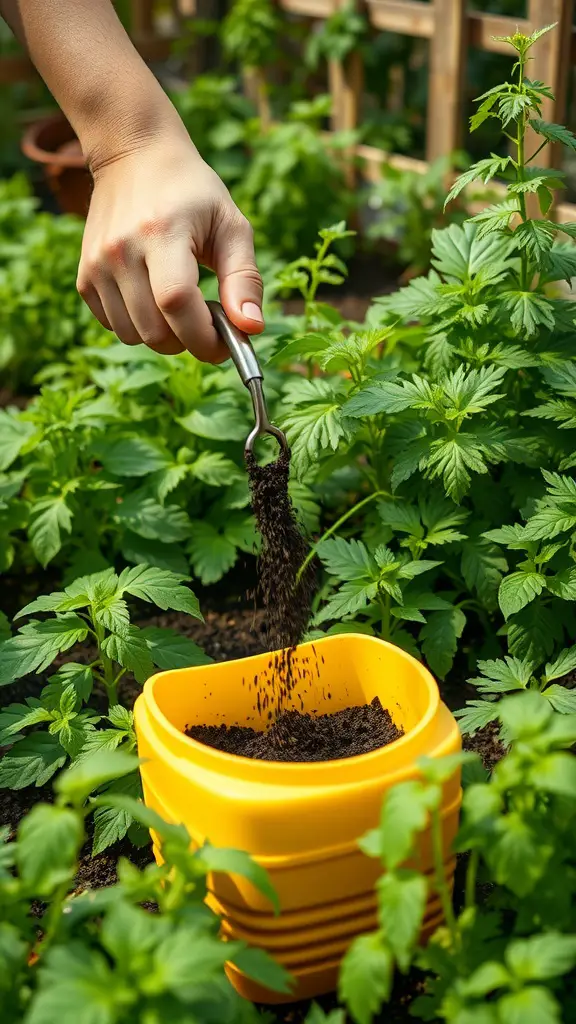
Unlock your outdoor herb garden’s full potential with smart fertilization. This image shows a simple method: adding nutrient-packed soil to a container. It’s an easy way to give your herbs the vital nutrients they need for thriving growth.
Successful herb gardening begins with premium soil. The yellow container shown offers a practical solution for organizing your plant nutrients. Fill it with compost or natural fertilizer to provide your herbs with essential nourishment.
Basil, parsley, and cilantro flourish when fed consistently. A balanced fertilizer, containing equal parts nitrogen, phosphorus, and potassium, is ideal. However, use sparingly. Too much fertilizer can produce abundant leaves but diminish the herb’s flavor.
Compost tea is another fantastic method. Soak compost in water for a few days. Then, use this mixture to nourish your herbs. This natural liquid fertilizer gently strengthens your plants. It helps them remain vibrant and full of flavor.
In conclusion, fertilizing your herbs carefully ensures a thriving garden. Experiment with various techniques and witness your herbs flourish! This updated approach for 2025 will help you achieve optimal results.
Organic Pest Control for Herb Gardens
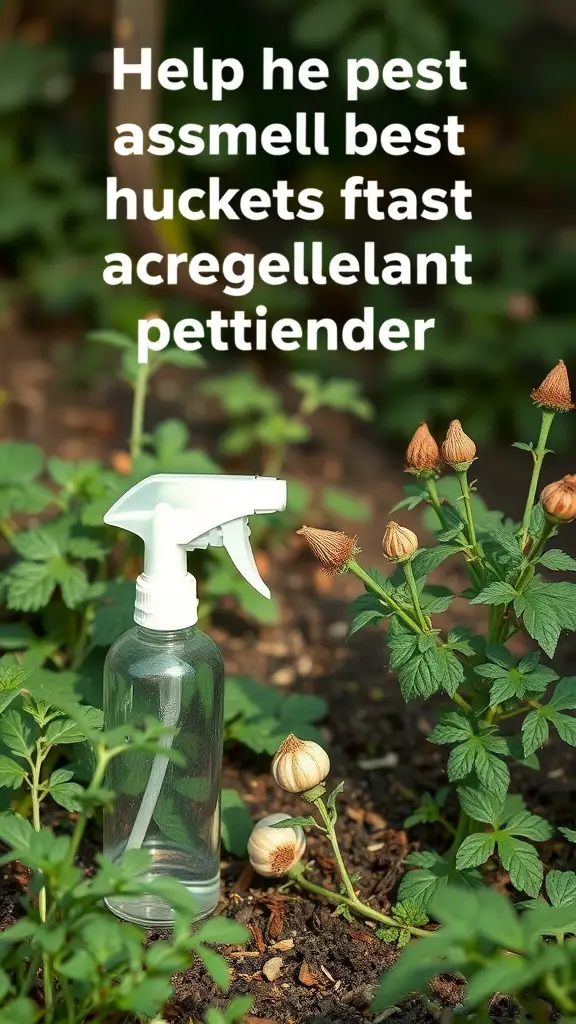
Maintaining a thriving herb garden in 2025 requires proactive plant care. This image showcases a spray bottle, a vital tool in a vibrant, green herb garden. It represents a straightforward approach to organic pest management. Employing natural techniques ensures a safe and healthy environment for your herbs and your family.
Herb gardens often face pest challenges. Luckily, you can manage them naturally, avoiding harsh chemicals. A simple solution is mixing water with a few drops of mild dish soap. Spray this mixture on affected plants to deter pests effectively.
Essential oils offer another effective solution. Peppermint and neem oils are excellent for repelling insects. Simply mix a few drops with water in a spray bottle for a natural bug deterrent. This updated method remains a popular choice in 2025.
Furthermore, consider companion planting. Basil, when planted near tomatoes, acts as a natural pest repellent and boosts tomato growth. Achieving garden equilibrium is key!
Seasonal Herb Planting Calendar
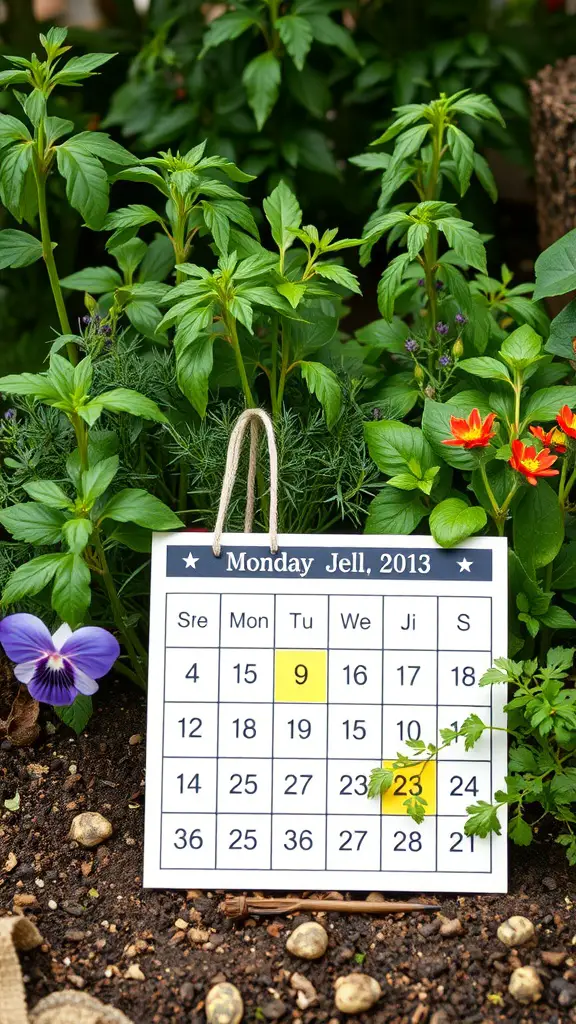
This stunning photo showcases a flourishing herb garden next to a calendar. It highlights the crucial role timing plays in successful gardening. Key dates are marked, pinpointing optimal days for planting and tending to your herbs.
Culinary herbs such as basil, cilantro, and parsley enhance our meals and follow seasonal growth patterns. Understanding optimal planting times ensures a thriving herb garden. Knowing which herbs prosper in spring versus autumn is beneficial for successful cultivation.
Thinking about growing herbs? Begin your seeds inside a few weeks before the final frost. When the weather gets warmer, move them outdoors. A calendar, similar to the one pictured, can help you monitor key dates.
Unsure about the perfect harvest time? Track your planting dates on a calendar. This simple step maximizes herb flavor and promotes healthy growth all season long.
Pruning and Harvesting Your Herbs
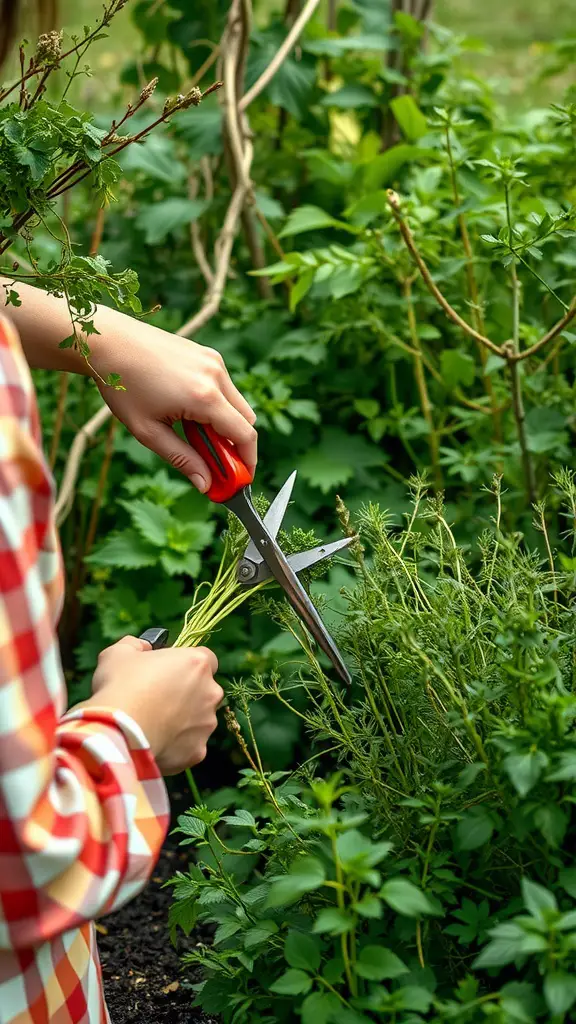
Keep your herb garden thriving with regular pruning and harvesting. The image shows someone expertly trimming herbs, emphasizing how crucial this step is. Effective pruning promotes robust growth and intensifies the taste of your herbs.
For optimal pruning in 2025, make cuts slightly above a leaf node. This encourages fuller, more compact growth, stopping plants from getting too tall and sparse. Basil and thyme thrive with frequent pruning. Harvest generously; increased picking leads to increased yield!
Harvesting is a rewarding aspect of gardening. Cutting fresh herbs to use in your cooking elevates your meals. Imagine adding freshly picked basil to a caprese salad. Or, consider incorporating thyme into your next roasted chicken. Always remember to wash your freshly harvested herbs before adding them to your recipes.
For optimal flavor, prune and harvest herbs during the cool early morning or late afternoon. This is when their essential oils are most concentrated. Consistent care will ensure a flourishing herb garden, offering fresh ingredients throughout the growing season.
Creating a Herb Spiral for Space Efficiency
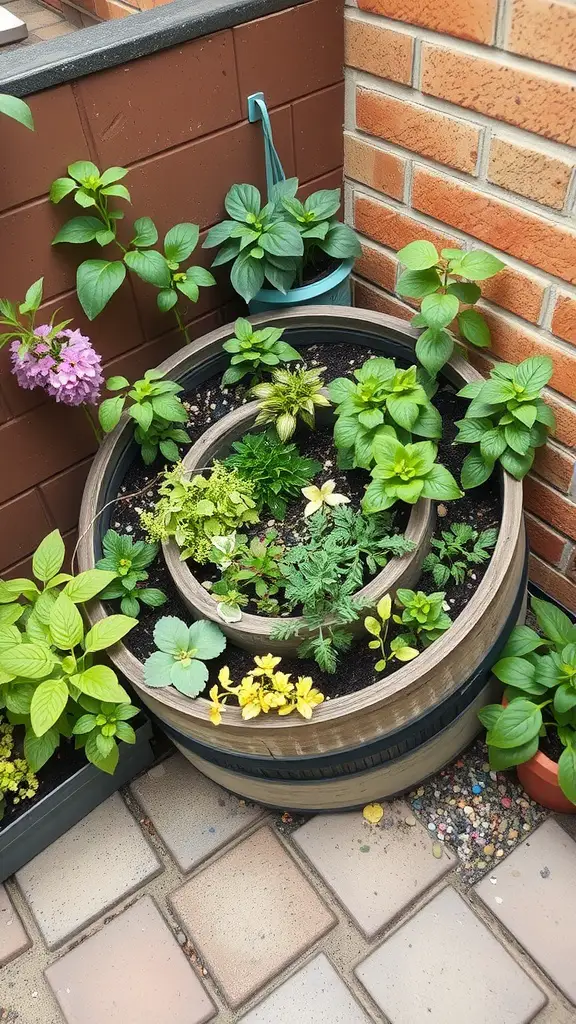
Herb spirals offer an excellent way to optimize your garden, especially when space is limited. The image showcases a stunning herb spiral, perfectly situated in a small area. This innovative design enables a diverse collection of herbs to thrive, even in tight spaces.
The spiraling design fosters diverse microclimates. This is perfect for herbs with unique sunlight and moisture demands. The spiral’s peak enjoys ample sun and excellent drainage. This makes it ideal for Mediterranean herbs such as rosemary and thyme. Conversely, the lower sections retain moisture, benefiting herbs like mint and parsley.
Begin your herb spiral by establishing a solid foundation. Consider using a robust wooden barrel or natural stones. Next, construct the spiral shape upwards using soil. Plant your hardier herbs in the broader, outer sections. Then, populate the inner spiral with more fragile varieties. This attractive design provides easy access and keeps your herbs neatly arranged.
Look closely! You’ll see companion plants nestled within the spiral. These attract helpful insects and repel unwanted pests. Adding flowers or other plants boosts both the beauty and functionality of your herb spiral. It’s a fantastic addition to any garden!
Preserving Herbs for Year-Round Use

The image showcases a beautiful arrangement of newly picked herbs drying on a wooden rack. This easy and efficient preservation technique lets you savor your garden’s bounty throughout the year.
Drying herbs by hanging them remains a popular method. It saves space and adds a touch of natural beauty to your kitchen. The herbs retain their vibrant green color, highlighting their freshness as they dry. Jars of preserved herbs and other culinary staples in the background suggest the pleasures of cooking at home.
Want to keep your fresh herbs longer? Begin by picking vibrant, healthy sprigs. Ensure they are thoroughly clean and completely dry. Bundle the stems together using string or kitchen twine. Hang the bundles upside down in a dark, warm, and well-ventilated space. After several weeks, you’ll have perfectly dried herbs, ready to enhance your culinary creations.
After drying, keep your herbs in sealed containers. Clearly label each jar. This ensures your favorite herbs are always on hand! Use them to brighten soups or elevate salads. Preserved herbs add a wonderful flavor to any dish.
Herb Garden Design Ideas for Aesthetic Appeal
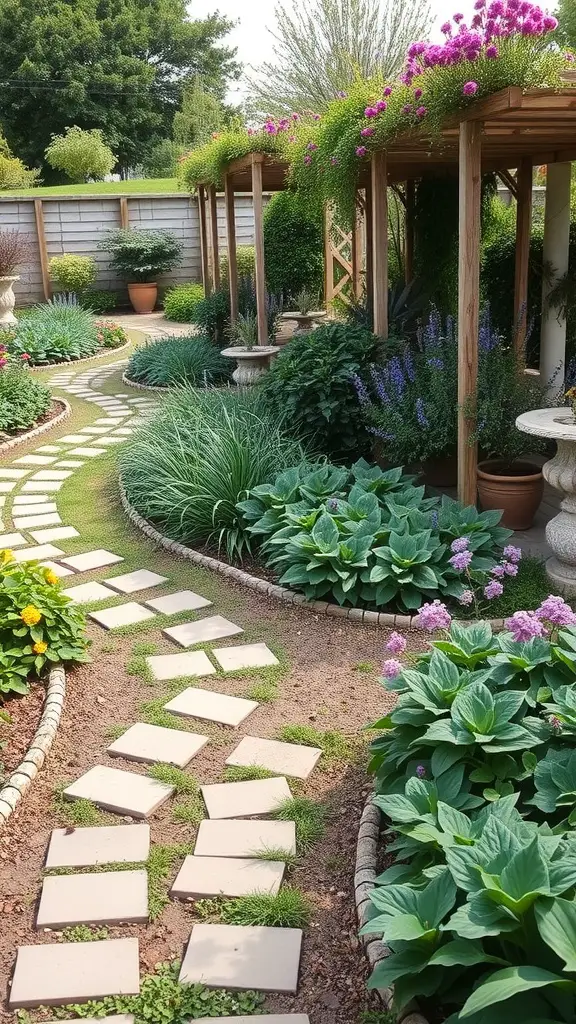
Transform your outdoor area into a tranquil haven by cultivating a stunning herb garden. The picture showcases an exquisite garden design, featuring meandering paths and a vibrant assortment of herbs. This layout encourages exploration, blending functionality with visual charm.
Observe the garden’s use of natural stone pavers, crafting an enchanting walkway. These stones clearly define the path through lush plants, leading you by colorful blooms and fragrant spices. The curved design introduces a gentle, natural ambiance, softening the garden’s appearance and enhancing its appeal.
Elevate your garden’s beauty and functionality by integrating raised beds or trellises adorned with vibrant flowering plants. These flowers draw in helpful insects, boosting pollination and pest control. The structured elements introduce visual interest and vertical layers to your garden design. This blend of herbs and flowers provides a rich sensory experience, uniting captivating sights and delightful fragrances.
Also, think about using pots and planters for herbs needing special care or particular soil. This makes them easy to reach and enhances your garden’s look. Smart placement turns even tiny areas into thriving herb gardens.
Attracting Pollinators to Your Herb Garden
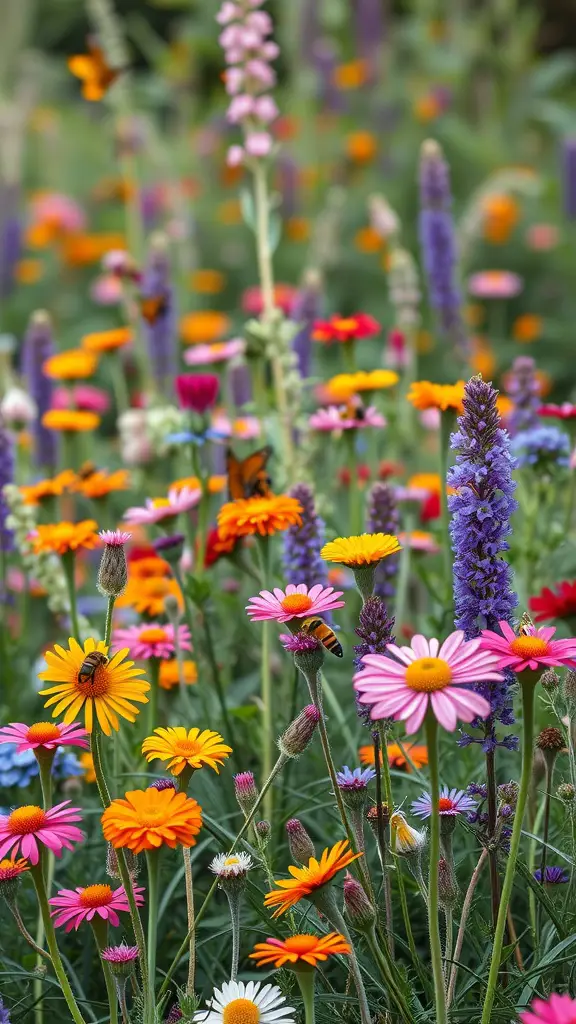
Cultivating a thriving herb garden goes beyond simply growing plants. It’s about creating a welcoming haven for nature. This image highlights a diverse array of colorful flowers. Each flower is crucial for attracting pollinators such as bees and butterflies. These vital insects are essential for the healthy growth of your herbs.
Pollinators love vibrant colors and enticing aromas, both abundant in these flowers. Adding diverse blooms near your herbs attracts more bees and butterflies. This boosts your herbs’ flowering and seed production, leading to a richer garden harvest in 2025.
Think about planting flowers such as daisies, cornflowers, and calendulas. These are great for attracting pollinators. Also, consider herbs like basil, thyme, and mint. They offer extra nectar. A diverse garden attracts more pollinators.
Protect pollinators by avoiding pesticides. Create a welcoming habitat for them instead. Offer water and shelter to encourage them to stay. With minimal effort, your herb garden can become a vibrant haven for these essential creatures in 2025.
Medicinal Properties of Common Herbs
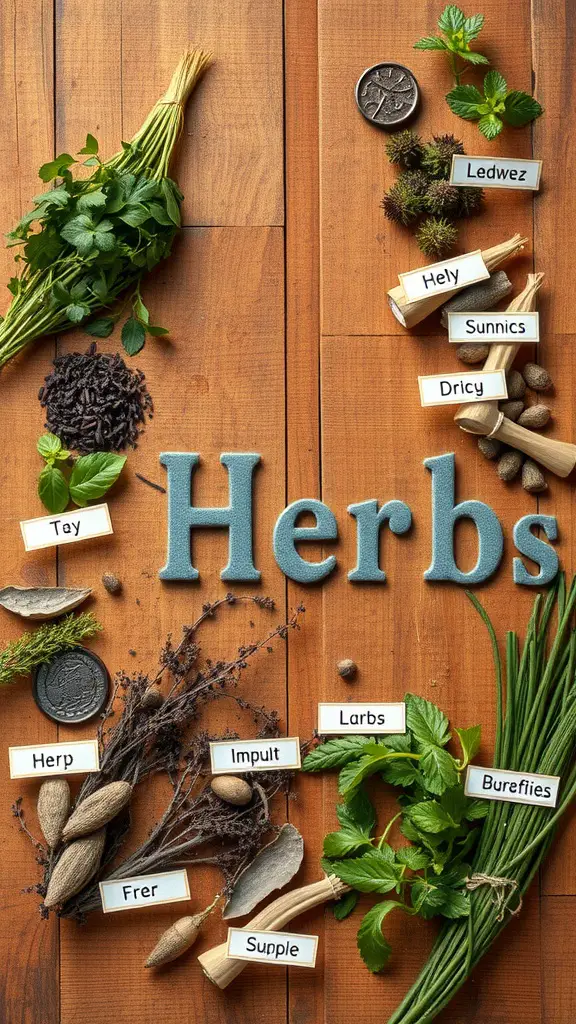
The image displays a colorful assortment of herbs arranged on a wooden table. Each herb is clearly labeled, highlighting its specific name. This presentation emphasizes the long-standing history and vital role of herbs in traditional healing practices.
Common backyard herbs, such as mint and thyme, provide numerous benefits beyond their culinary uses. Mint can ease digestion and alleviate headaches. Thyme boasts antimicrobial qualities, making it a favored option for immune support.
This setup features calming herbs such as lavender and rosemary. Lavender is well-known for its soothing properties, often used to ease anxiety and promote better sleep. Rosemary isn’t just for cooking; it’s also associated with enhanced memory and focus.
Incorporating these herbs into your daily routine is straightforward. Brew them into soothing teas. Add them as flavorful sprinkles to your dishes. Craft personalized essential oil blends in your own space. Each herb offers distinct advantages. This lets you customize your selections to match your specific health goals.
Herbs That Deter Common Garden Pests
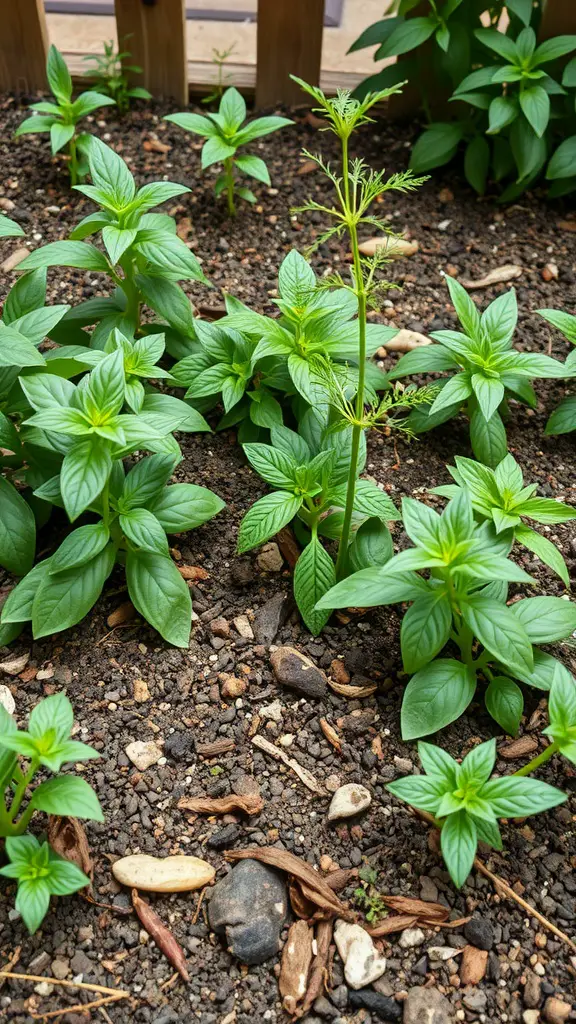
The picture showcases lush, green herbs flourishing in a carefully cultivated garden. These plants offer more than just visual appeal; they naturally repel pests. Strategically planting herbs such as basil and cilantro around your garden provides a natural defense against unwanted insects.
Basil offers excellent protection from flies and mosquitoes. Its potent aroma disorients these insects, deterring them from infesting your garden. Strategically placing basil plants near other vegetables establishes a natural pest repellent zone.
Cilantro, conversely, draws in helpful insects like ladybugs. These ladybugs consume common garden pests, including aphids. Planting cilantro is like inviting allies into your garden, naturally managing pest populations.
Beyond the usual suspects, mint and rosemary offer natural pest control. Mint effectively repels ants and beetles. Rosemary keeps flies and mosquitoes away. Grow these herbs to safeguard your garden and enjoy fresh flavors in your cooking. They are a win-win for any home gardener in 2025.
Herb Garden Maintenance Tips for Longevity
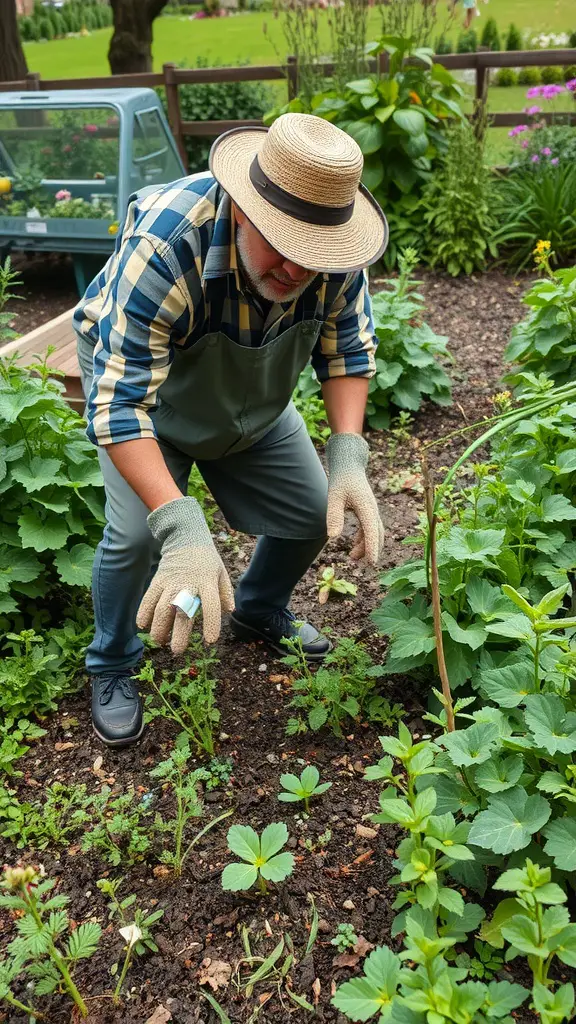
Maintaining your herb garden is essential for a consistent and plentiful harvest. The image shows a gardener, equipped with a straw hat and gloves, carefully nurturing the thriving plants. The lush greenery surrounding him highlights the rewards of a well-kept herb garden.
Consistent watering is key for healthy herbs. They flourish in soil that drains well, so avoid overwatering. Before watering, check the soil’s moisture. If the top inch feels dry to the touch, it’s time to water your herbs.
Now, prune your herbs for optimal growth. Pruning promotes fuller plants and reduces disease risk. The gardener’s close inspection in the photo is excellent practice. Regularly check for and remove any dead leaves or spent flowers.
Feeding your plants is key. Opt for eco-friendly, organic fertilizers to nourish them without damaging our planet. Apply fertilizer carefully; overdoing it can harm your plants.
Stay vigilant against pests. Routine inspections enable early detection of problems. The gardener’s focus on their plants serves as a great reminder to remain watchful.
Using Herbs in Natural Home Remedies
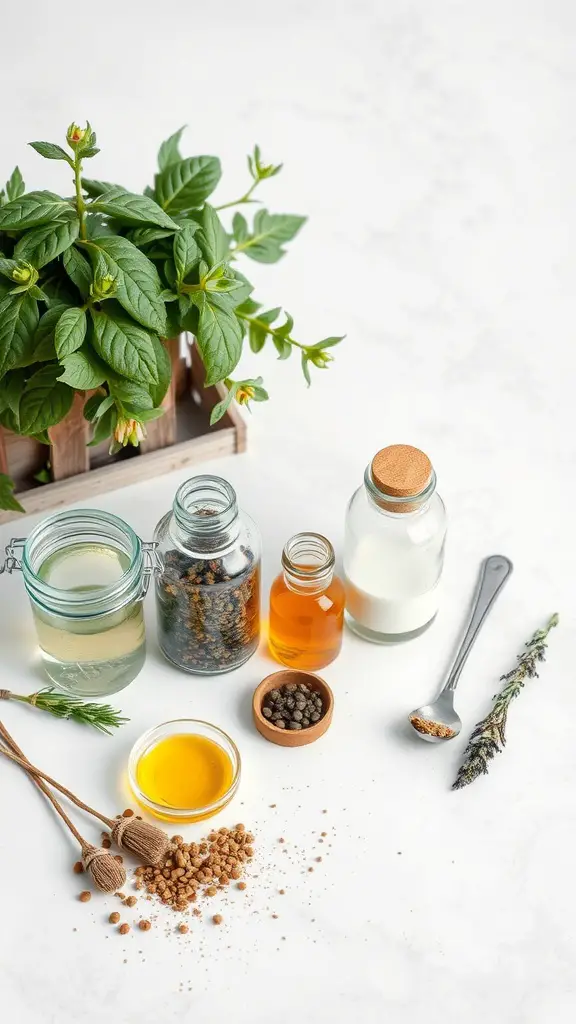
Beyond culinary uses, herbs offer significant health advantages. This image showcases a vibrant, fresh herb, potentially ready for natural remedies. Cultivating your own herb garden ensures convenient access to these beneficial plants.
Before you lies an array of containers. They hold various liquids and powders. Expect to find herbal extracts, essential oils, and dried herbs. These are vital for creating effective home remedies. For example, you can make infused oils by soaking herbs in a carrier oil. These oils are excellent for calming irritated skin.
Numerous herbs possess unique beneficial qualities. Rosemary and lavender, for instance, are known to reduce stress. Conversely, ginger combined with honey can soothe digestive discomfort. Keeping these herbs readily available empowers you to create easy, homemade solutions.
Crafting a herbal remedy can be simple. Think honey and ginger for a comforting beverage, or lavender oil for stress relief. The options are vast! Why not cultivate your own herb garden and discover the advantages of natural, homemade solutions?
Herbs That Do Well in Shade

Imagine an herb garden. Sun-drenched spaces often come to mind. Yet, many herbs flourish in the shade. This image showcases a thriving herb garden in a shady corner. Its diverse leafy greens hint at a wealth of flavors and culinary possibilities.
Parsley, chives, and mint are excellent herbs for shady spots. They don’t require direct sunlight to grow well. This makes them ideal for gardens with limited sun exposure. Parsley enhances salads and meals with its fresh flavor. Mint is perfect for adding a refreshing touch to drinks and desserts.
Crafting a thriving shady herb garden begins with excellent soil preparation. Prioritize a nutrient-rich, well-draining mix to promote robust herb growth. Plant your herbs in close proximity; many benefit from companion planting. Water consistently, but avoid oversaturation, as shaded locations tend to retain moisture longer than sunlit areas.
Harvest your herbs frequently. Regular harvesting boosts growth. Enjoy fresh flavors in your cooking. A little care ensures a delightful herb bounty all season. Your shaded herb garden will thrive!
Exploring Heirloom and Rare Herbs for Your Garden

Elevate your outdoor herb garden with heirloom and rare varieties! Discover unique flavors and add excitement to your culinary creations. The image showcases a diverse collection of carefully labeled herbs and plants. These special herbs offer distinctive tastes and connect you to a rich botanical heritage.
Think about cultivating aromatic herbs such as Lemon Balm or Bee Balm. They offer both lovely fragrances and culinary applications. Picture yourself picking fresh mint for a cool beverage on a warm day. Or using delicate chervil in a sophisticated dish. These herbs are more than just plants. They’re an opportunity to discover new tastes and time-honored customs.
Discover heirloom herbs! These plants, cultivated for generations, possess distinctive traits. They spark engaging conversations with loved ones, weaving tales of their past into your culinary creations. Imagine sharing the captivating history of your garden’s lavender or the specific needs of your unique basil types. It’s a delightful way to connect with your heritage and share it with others.
Elevate your herb garden this year by incorporating unique and uncommon varieties. Discover exciting new flavors and unlock culinary inspiration. Imagine crafting a simple herb butter using your own fresh herbs to transform any meal. Simply blend softened butter with finely chopped herbs, a dash of salt, and a splash of lemon juice for an unforgettable taste.
As you discover unique and vintage herbs, consider their vast potential. Use them in your cooking or simply admire their charm. They’re guaranteed to enhance your garden in 2025.
Connecting with Nature Through Herb Gardening

Growing herbs is a wonderful way to engage with nature. Enjoy fresh ingredients readily available. This photo perfectly shows someone enjoying their outdoor herb garden. The lush green plants create a peaceful setting. It encourages everyone to participate in gardening.
The garden flourishes with diverse herbs, each boasting a distinct aroma and taste. Envision gathering vibrant basil for fresh pesto or harvesting rosemary for a delicious roast chicken. These simple connections with nature offer immense satisfaction.
Growing herbs cultivates patience and presence. Each plant requires care, from watering to pruning and harvesting. These activities connect you deeply with nature’s rhythms. Witnessing your herbs flourish brings immense satisfaction!
Thinking about starting an herb garden? Consider your favorite recipes! Herbs such as cilantro, mint, and thyme can enhance your cooking easily. Imagine the satisfaction of using homegrown ingredients. It’s more than just herbs; it’s connecting with nature.
Creating a Vibrant Herb Garden Layout
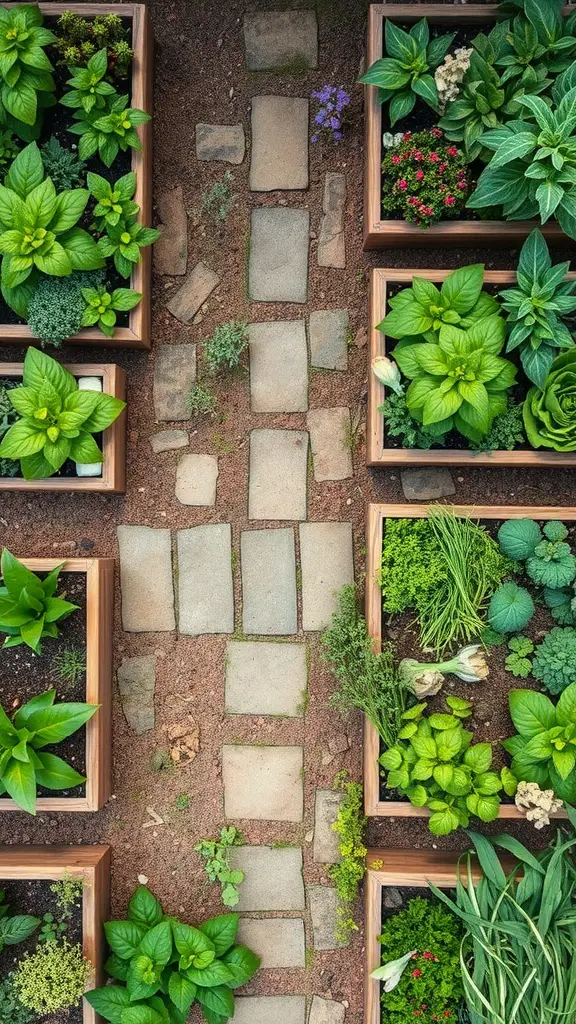
Crafting your herb garden? Layout is crucial for aesthetics and practicality. This image showcases raised garden beds brimming with diverse herbs. Each section is well-organized, simplifying plant identification. A stone path winds between the beds, offering easy access and a delightful garden walk. Consider this design for your 2025 herb garden project.
Raised garden beds are excellent for controlling soil conditions and water runoff. Plant basil, thyme, and parsley together for convenient harvesting. Enhance your garden’s visual appeal with diverse colors and textures. The lush green foliage combined with bright flowers creates an energetic and beautiful space. These tips are updated for 2025 gardening practices.
Remember to space your plants adequately! Each one requires sufficient room to flourish. Proper spacing also improves air circulation, minimizing disease risks. Furthermore, a clear path simplifies maintenance, allowing access to your plants without soil compaction.
Elevate your culinary creations by using diverse herbs. They also draw helpful insects to your garden. Consider planting mint or rosemary for a delightful scent. With careful planning, you can create a beautiful herb haven in your yard.
Seasonal Herb Maintenance Tips

Maintaining a vibrant herb garden requires consistent seasonal care. This ensures your plants remain healthy and productive throughout the year. The image showcases a dedicated gardener nurturing their herbs. It emphasizes the practical, hands-on effort essential for successful herb growing in 2025.
Begin by inspecting your herbs frequently for pests or diseases. Spotting issues early means faster solutions, keeping your plants healthy. Opt for organic pest control to protect your garden’s well-being.
Proper watering is key, but avoid overwatering. Herbs thrive when the soil dries slightly between waterings. Check the soil moisture by inserting your finger about an inch deep. Water only if it feels dry to the touch.
Regular pruning is key for healthy herbs. Trim excess growth to stimulate new shoots and enhance airflow. This simple step keeps your plants neat and promotes vigorous growth.
Finally, rotate your herbs every season. This prevents soil nutrient loss and minimizes pest issues. Trying new herbs annually keeps your garden vibrant and interesting!
Herb Garden Workshops and Community Events
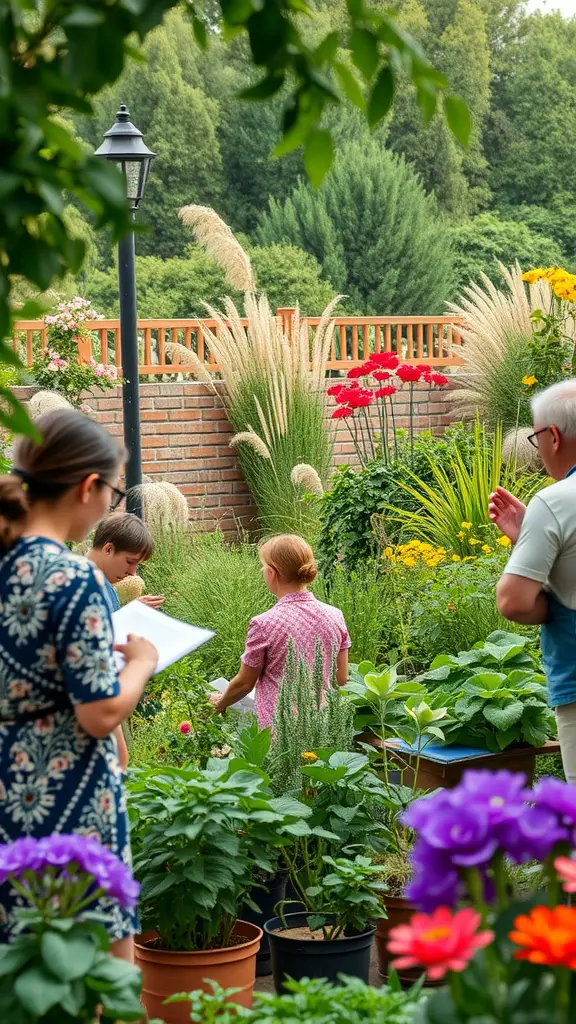
Discover the joy of cultivating your own herbs with our engaging herb garden workshops! This image showcases a group immersed in a flourishing garden, brimming with colorful plants. They’re actively participating in a hands-on learning experience, likely exploring various herbs and exchanging valuable gardening advice. Join us in 2025 to unlock the secrets of successful herb gardening!
Local gatherings like these build strong community bonds. They offer valuable insights and chances to forge new friendships. From novice to expert, every gardener will discover something engaging and informative here in 2025.
In these engaging workshops, attendees typically plant their own herb gardens. Popular options are basil, mint, and rosemary. Once planted, you can bring your herbs home for culinary use. Growing your own fresh ingredients is a truly satisfying activity!
Once your herbs are planted, explore exciting recipes using your homegrown bounty. A simple herb-infused olive oil is a great choice. It enhances any meal. You’ll need fresh herbs, olive oil, and a jar. Chop the herbs, combine them with the oil, and let the mixture infuse for a few days. Savor the vibrant flavors in your cooking.
Join our updated 2025 local herb garden workshops! Discover a great chance to learn, cultivate, and connect with fellow gardening enthusiasts.

